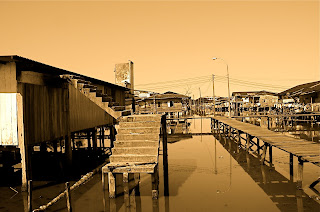
Kota Kinabalu: They were the first Filipino group to climb Mt Everest from its north face and reach the top not just once but three times! Now they have decided to test their mettle on something equally extraordinary.
"Going to the sea in an ancient migratory barangay sail boat is more than coming down to earth," joked Art Valdez, 61, leader of "Voyage of The Barangay" which sailed into the beach off Kinabalu Yacht Club, Saturday.
Before breaking into international waters into Sabah on its way down to Singapore, then upwards to Vietnam and Shanghai, Valdez and his flotilla of three barangays had spent a year sailing around the Philippines, making 80 stops in all.
The international leg first took them to Sandakan, then up to Kudat, around the tip of Borneo to Kota Kinabalu. Everywhere they went, they were greeted with rousing welcome.
"We are out to show the young the sea is part of the natural environment and part of the natural highway for the peoples of the Philippines and Southeast Asia," said Valdez, a friend of Tengku Datuk Dr Adlin, Chairman of Sabah Tourism Board.
"It unifies rather than divide us," Valdez added.
"What we are riding on is a closest possible replica of a boat dug up in coastal waters of Butuan City, Mindanao, which was carbon-dated to 320AD or the 4th Century," noted Valdez.
"Riding that now and purely powered by wind and sail gives the young confidence that we can do it again the way our forefathers did it."
The significance of the Butuan barangay rests on the fact that it was the first wood watercraft ever dug up in Southeast Asia. Hence the artifact is evidence of early Filipino craftsmanship and their seamanship skills before the arrival of Spanish colonisers.
The barangay is believed to be the chief means by which the ancestors of Filipinos migrated to the country. "Its original builders are our nomadic seafarers - the people of Samar who are the Bajaus of the Philippines, similar to the Bajaus in Semporna. The Barangay is like your lepa but this is a big lepa - 61ft long, 11ft wide, 5ft tall while the second one is 81ft long and 14ft wide," Valdez said.
"The boats are built with no plan, no design, no measurement except on the head of the master builders and fastened with wood pegs and only two people can do it - the Samar people and one trip in northern Philippines," Valdez said.
Barangay is an Austronesian word meaning "sailboat" but when the Spaniards arrived in the 16th century, they found the Filipinos already had a civilisation of their own and living in well organised independent villages called barangay.
"Voyage of The Barangay's passage to Kota Kinabalu from the Philippines with Shanghai as their destination hopefully by October, is part of a yearning to trace the migration route of our forefathers.
Not just Filipinos but also the people of Southeast Asia, the people who live in the Pacific and even the Indian Ocean," Valdez explained.
"Our forefathers came from the southern coasts of mainland Asia, in Southern China, Vietnam and Cambodia," he said.
In the interest of safety, they hug the coast down Borneo and up Indochina rather than facing the big waves crossing the Bashi Channel going north to Taiwan from the Philippines.
"The barangay built to the original specifications using wooden pegs to hold things together is not structurally strong to stand up to very rough waves.
"In fact we experienced a scare in Mindanao where our boat almost got smashed," he said.
"The weather is the challenge but our biggest danger is the possibility of being hit by big ships because we are wooden and so we can't be seen on their radars," Valdez said.
To avoid this threat, a radar detector is fitted at the tip of the mast of one of the three baranays which together carry a total of 35 voyagers.
Tougher still is to comply with the legal requirements of the international stops which is riddled with bureaucracy, Valdez said.
The barangay will be opened for public viewing between 9-11 am and 3-5pm today (Sunday), to learn the purpose and history, said Ms Quek I-Gek, Sales and Marketing Director of Mountain T0RQ Sdn Bhd.
"One purpose is to raise funds to help cover the cost of completing several thousand nautical miles which needs quite a lot of money," said Ms Quek.
Their corporate sponsors include San Miguel Corporation, Tao Corporation, Holcim, Agatep Associates and Coleman. Ms Quek's contact is 019-8138162.



